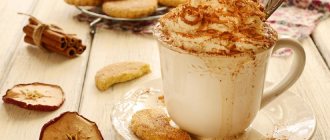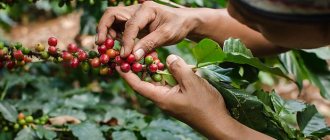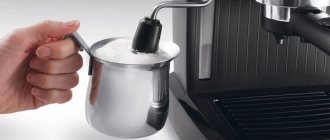General idea of cappuccino
Cappuccino was invented hundreds of years ago by Italian Capuchin monks. The drink consisted of coffee and milk with high fat content, at that time goat milk was used for preparation. Today there are many recipes known that make it possible to obtain such coffee; an integral component of each of them is milk whipped to a thick foam.
The classic cappuccino recipe involves strong espresso, frothed milk and thick milk foam.
Also, other ingredients are added to the drink that significantly affect its taste: chocolate, all kinds of syrups, etc. As a rule, the composition of cappuccino varies depending on the location of preparation. At first, the drink was whipped by hand, and then a special device (cappuccino maker) was invented, consisting of two containers: for milk and water. The steam generated by heating the water flowed through a tube into a container with milk, whipping the product into a thick foam. Modern coffee machines whip up steam on their own.
Can I use cream?
Some people will find cappuccino with cream tasty, some will not. The rich, creamy aftertaste adds zest to the drink and reveals the flavors of coffee in a new way.
Interesting! Is it possible to grind coffee in a blender?
Gourmets love to experiment and create unique recipes, whipping dairy products in various ways (blender, mixer), and not just using automatic cappuccino makers.
Expert opinion
Vadim Kudryavtsev
Coffee expert, professional barista and simply in love with this aromatic drink.
Ask the barista a question
Everyone chooses the percentage of fat in the cream according to their own taste; 10% and 50% are suitable. For proper cappuccino, it is better to buy cream with a fat content of 10-15%.
When whipped, heavy cream forms lumps that look unattractive and taste unpleasant.
Cream with a fat content of up to 15% forms a uniform, smooth foam with a pleasant texture and dissolves in coffee.
Milk fat content value
The level of fat content determines not only the taste of the drink, but also its consistency. The optimal indicator for making cappuccino is 3–4%. This milk can be called the golden mean: it is not watery, but not too fatty, which makes it possible to achieve the ideal combination of taste and density of coffee. It also produces a signature foam: sweetish-creamy and thick, for which cappuccino is valued.
A drink made from milk with a low fat content (1–2%) does not differ much in taste from its counterpart with a fat content of 3.5%. However, this coffee seems too liquid. Sometimes the barista mixes milk (3.5%) with skim milk. This decision is absolutely wrong, and the difference is clearly visible.
When using milk with low fat content, a dry and fairly dense foam is obtained, which gives the coffee a gray tint, but does not make its consistency thicker.
You can get a fragrant and rich cappuccino only with the addition of milk of 3–3.5% fat.
How to froth milk for cappuccino and which one to buy?
In terms of volume, milk is the most important ingredient in most espresso-based drinks and should therefore be prepared with the same care and attention that is given to coffee extraction.
Baristas must understand that the quality of milk from the same supplier varies throughout the year due to changing seasons and changes in the milk supply of dairy cows.
Barista tasks when heating milk
When heating milk, the barista must solve a number of basic problems:
- Pour only enough milk to prepare the drink(s) at that time.
- When foaming milk, achieve a dense consistency with microbubbles; The surface of the milk should be smooth, without visible bubbles.
- Bring the milk temperature to the required level (65°-70°).
- Plan your actions in advance so that the heating of the milk and the extraction of the espresso are completed almost simultaneously.
- Serve drinks before milk separation occurs.
The milk must not be boiled—it is useless to whisk after boiling:
- firstly, it does not whip well, because... its “structure” changes when boiled; in fact, it can be considered that it has already been whipped once with overheating;
- secondly, when whipped and heated to 65°-70° C, milk acquires a noticeable sweet taste, which is an essential component of cappuccino (the difference in sweetness is noticeable even between pasteurized and sterilized milk).
When overheated (above 75°-80° C), the sweetness disappears. Sweetness will no longer appear in boiled milk.
For frothing milk, it is not the fat content that is important, but the protein content. In Europe, regular milk contains 3.3% protein, but here we have a maximum of 2.8%. Abundant foam is obtained from any milk, this is a matter of skill, but the consistency of this very foam depends only on the milk. From high-protein it turns out viscous and oily, and from low-protein it is dry and “coarsely bubbly”.
What kind of milk should I buy at the store?
From what almost all chains have is Parmalat 3.5%, you may notice that it is also used in most cafes in your city, just watch. Some brands make “special” milk for cappuccino, such as Rioba. Valio milk is also good in composition and frothability. We recommend starting testing with these brands; don’t be discouraged if something doesn’t work out for you the first time. You probably need to work on your technique as well. Watch more videos.
Milk frothing technology
The beating process itself, once you feel it, is very simple and consists of two stages:
- Stretching (foaming) - increasing the volume of milk (producing foam).
- Steaming (steam heating) – heating and formation of texture.
To make foam, the first step is important; for microfoam, the second step is important. Foaming occurs only as long as the milk is cold, the temperature is below 37° C.
At the first stage, the main thing is to feel the position of the nozzle a few millimeters below the surface of the milk, at which foaming occurs, accompanied by a hissing sound and rotation of the milk. As the milk volume increases, the pitcher moves lower so that the whistling sound does not stop. The end of the nozzle should be located near the edge of the pitcher. If you look from above and take the pitcher's spout at 12 o'clock (the steam tube also comes from the area of the spout), then the nozzle is at 4-5 o'clock. In this case, it is better to tilt the pitcher slightly towards 3-4 o’clock. If you continue the first stage after warming the milk, the foam will be dry. As soon as you feel the warmth on the pitcher’s wall with your hand, proceed to the second stage.
Lower the nozzle down the wall and try to make the milk in the pitcher rotate (as if it were being rotated strongly with a spoon). Heat until you can “comfortably” hold the side with your hand, the temperature is 65-70° C. At the second stage, it is important not to overheat the milk, otherwise it will have a nasty boiled taste and no sweetness. And foam, by the way, too.
The end of the nozzle should be positioned near the wall of the pitcher, always at an angle to the surface of the milk (not perpendicular). Coffee machines just have a slight inclination of the steam wand and it is quite enough.
A very large video about frothing milk on different machines.
Gail shows us the technique of preparing milk, gives useful tips and points out the nuances to remember when you froth milk. The video is in English, you can turn on subtitles, if you have problems with this, then at least watch it!
Another example of how to froth milk:

How to froth milk for cappuccino and which one to buy?
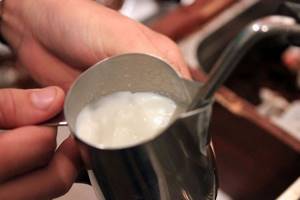
Number of votes: 168 3
5
1
168
Was the information helpful? Rate and leave a comment? Better yet, share!
Comments
We will be glad if you share your opinion or add to a note or article.
Lactose and protein content
The amount of protein contained in the drink affects the quality characteristics of the foam:
- gives stability that allows it not to settle for a long time;
- makes the creamy taste more pronounced;
- imparts elasticity.
Be sure to read: Coffee with lemon: what are its benefits and how to prepare
It is possible to achieve this effect provided that milk containing at least 3 g of protein is used to prepare the cappuccino.
For cappuccino, only natural products are chosen, excluding the presence of various powders.
The classic sweet taste of the foam is provided by milk sugar (lactose). When heated, it splits into two components: galactose and glucose. It is possible to get a “cap” with a rich taste only if the carbohydrate content is not lower than 4 g. Due to lactose intolerance by some people, good coffee shops prepare lactose-free cappuccino with a top that is not inferior in taste to the classic version.
Suitable milk temperature
The rules for preparing high-quality cappuccino require the use of milk at a temperature of +4 °C. In addition, the product should not be boiled before beating. In the process of obtaining foam, it is important not to exceed the temperature, varying in the range: +67… +75 °C. Otherwise, protein compounds will be destroyed, the drink will acquire an unpleasant odor and bitter taste, and the foam will not meet the stated characteristics.
Milk is whipped only in a dry pitcher, since contact of this product with moisture significantly impairs the frothing process.
Characteristics of the right foam
The following signs indicate the quality of cappuccino foam:
- Uniform consistency, presence of bubbles. High-quality foam flows slowly from the spoon, and its height is maintained for a long time.
- The presence of a pronounced ice cream flavor , which can be achieved only from milk with the required fat content.
- Stickiness , which gives the drink a subtle taste and depends on the amount of protein contained in the product.
Also, the quality of foam is determined by such indicators as:
- chilled – colder milk whips faster and produces a stable foam;
- functionality of the device used for whipping; Over time, they become clogged and lose their original effectiveness.
Tips for choosing milk
When choosing, it is worth remembering that whole or natural fresh milk is not suitable for coffee machines, since their use significantly slows down the whipping process. Cappuccino is prepared from a pasteurized or ultra-pasteurized product, since it whips easily and allows long-term storage at room temperature without losing its original qualities.
It is best to give preference to milk with a special mark on the packaging - for example, “for cappuccino”, “for coffee machines” or “for whipping”. Using these options guarantees high quality foam.
Correctly selected products are simultaneously suitable for all types of devices: cappuccino maker, frother and paranello.
Review of the best brands
Regardless of which device will be used to prepare cappuccino, it is important to choose milk that meets all the criteria. Professional baristas have identified several brands of this product, which, in their opinion, are considered the best for preparation:
- Rioba (3.5%, UHT). This brand's milk is prepared from normalized cow's milk and is considered an ideal option for making cappuccino coffee. The product whips well, does not require boiling, has a sweetish taste and forms a dense, stable foam.
- “Petmol” (3.2%, UHT). Made from natural ingredients, it has a natural taste. Milk of this brand allows you to achieve high-quality foam with a rich taste, even with a hand blender.
- “House in the Village” (3.2%, UHT, for cappuccino). The product has a bright taste and does not contain additives or preservatives. Thanks to the high protein content, the foam is thick and airy.
- “Molochnaya Rechka” (3.5%, UHT, for cappuccino). Made from natural milk, it whips easily into a dense, airy, stable foam with the taste of ice cream.
- “Prostokvashino” (3.5–4.5%, pasteurized or selected). It is characterized by high taste and quickly whips to the required consistency.
Be sure to read: Why is salt added to coffee and what benefits does it have?
Adding cream to milk for cappuccino
Why add cream to milk for cappuccino?
According to one version, cappuccino was invented by Capuchin monks who once lived in an Italian monastery near Rome. Initially, they added cream to coffee, which turned into foam when heated.
Later, hot whipped milk was used instead of cream. Nowadays, baristas mix cream with milk, following the ancient tradition of Italian monks, to create a unique taste and stable foam.
What kind of cream and when can I add it?

When purchasing coffee creamer, you should pay attention to its fat content. When added to coffee, 10% cream is most suitable because it dissolves better and does not form lumps.
Buy cream from Valio, which has a fat content of 30-38% - it creates a thick foam during whipping. If you cover the prepared coffee with a thick layer of whipped cream, and then sprinkle the foam with chocolate, you will get a delicious, invigorating drink with an amazing aroma.
Features of using plant milk and cream
To make cappuccino, it is permissible to use a plant product made from coconut, soy, cereals, almonds, rice and nuts. However, when choosing them, it is important to consider a number of nuances:
- Milk of plant origin does not allow you to get foam with sufficient thickness.
- The nut, coconut and almond product is characterized by a high calorie content (up to 150 kcal per 100 g), therefore, when whipped, it forms a fluffy foam.
- The calorie content of milk made from cereals and soy is 50 kcal per 100 g, so the foam is less fluffy.
When using plant milk, coffee loses its creamy flavor and thick consistency.
Some baristas prefer to make cappuccino from cream: its rich taste gives the drink new shades. To get the right coffee, it is recommended to choose cream with a fat content of 10–15%. In this case, the foam will be uniform, smooth and with a pleasant texture. A product with a higher indicator, when whipped, forms lumps that are unpleasant in taste and unattractive in appearance.
Cappuccino is one of the most popular drinks prepared in bars, restaurants and at home. To obtain the appropriate quality, it is important to use milk with suitable characteristics.
Which is better
Fresh or pasteurized
The full history of the creation of the coffee drink is described in the article “Cappuccino coffee: what it is and how to make it at home.”
Next, we will look at the features that need to be taken into account when choosing milk for cappuccino. Fresh, natural with a shelf life of up to 3 days will not work. Farm, homemade and other “ecological” products are also not suitable choices. It is better to choose “pasteurized” or “ultra-pasteurized”.
What milk do you choose for cappuccino?
RegularSpecial
Fat content
Fat content does not affect the preparation or appearance of the coffee drink. It affects the taste and thickness of the milk foam. The fattier the milk, the nicer and denser the whipped foam.
Full-fat milk is not suitable for cappuccino. It leaves an invisible film on the tongue, which prevents the coffee aftertaste from revealing itself, overshadows and muffles the aroma.
Do not take milk with fat content less than 3%, it will not froth.
But some people like full-fat milk or even cream in their coffee drink.
Interesting! What is Robusta and how is it different from Arabica?
Protein and lactose
Protein is responsible for the consistency of the foam. The more it is, the more pleasant the foam tastes. Per 100 grams of milk, the protein content should be 3 grams, but not less than 2.8 grams. Then the whipped portion will be strong, viscous and dense.
Lactose is milk sugar, but milk itself is not sweet. When heated, it breaks down into glucose and galactose. Therefore, the whipped foam tastes sweet.
If you want a sweet foam, choose full-fat or skim milk. It contains 4.8 grams of lactose per 100 grams. Lactose-free contains no more than 0.1 grams of milk sugar.
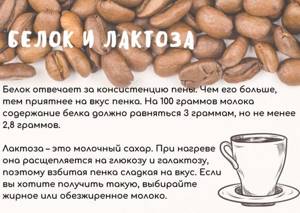
Shelf life and temperature for the drink
Always pay attention to shelf life. Milk with a shelf life of up to 3 days differs from UHT and sterilized milk. In factories, workers process them at an average temperature of 150 degrees. This kills harmful microorganisms. And the shelf life increases to 6 months. There is little benefit in such milk, but it will not cause harm either.
The temperature of the milk is also important when making cappuccino. You should not use warm at 30-40 degrees or room temperature at 25 degrees. It should be cold at 6 degrees. When heated, the viscosity and taste are lost, making it difficult to whip into foam.
If you like sweet foam, heat the milk to 60-65 degrees. To whip it properly, use a pitcher (stainless steel milk jug) and a mixer. They are included in coffee machines.
Which foam do you like best?
SweetUnsweetened
Package
Stores sell milk in tetrapacks, glass, bottles and polyethylene. Packaging does not affect the taste. But the duration and quality of storage depend on it.
The tetrapack is covered inside with a foil layer that protects from sunlight. In such packaging, the liquid does not turn sour and retains its properties for up to 6 months.
But the best container is a glass bottle, which does not react with liquid.
A good choice would be a bottle with a screw cap, a box with a dispenser, a lid or a beveled edge. A plastic soft bag costs 10-20 rubles less, but it is inconvenient to use. To keep it in shape, the contents must be poured into another container with a lid. Or purchase a plastic stand with a comfortable handle.
Plant milk: for or against
To make cappuccino, you can use plant-based milk from soy, coconut, almonds, cereals, nuts, and rice. But it is necessary to take into account the nuances and choose the right product.
Interesting! Coffee latte - composition and recipes for making it at home, history of origin
When churned, plant milk will not be as thick as animal milk. Coconut, almond, and walnut have a high calorie content of up to 150 kcal per 100 grams. And if you beat it, you get a lush foam.
The calorie content of cereal or soy milk is up to 50 kcal per 100 grams. It will produce less fluffy foam.
Well, the most important thing is the taste. When using plant milk, the creamy taste of coffee will disappear, and its structure will become watery.



